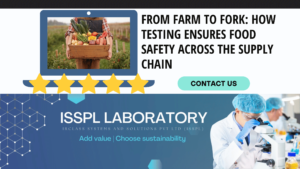An Overview by Team ISSPL - Analytical Testing Laboratory in India
ToggleHigh nutrient concentrations in dairy products make them an ideal habitat for microorganisms. Thus, the microbiological safety of these products is essential for both consumer health and the dairy industry.
Once harmful pathogens are detected in dairy items, it can result in several foodborne illnesses and demolish the image of a great many farm owners. Microbiological testing helps prevent the hazards that these microbial contaminants pose to consumers and comes in handy for evaluating the safety of a finished product.
The Importance of Microbiological Safety in Dairy
Milk and milk products (cheese, yogurt, butter) have a short shelf life because they contain instability factors such as high moisture content. Thus, they are prone to infection with bacteria, yeast fungi, and viruses
. Other microorganisms are beneficial and actively added to some dairy products to contribute health benefits beyond basic nutrition. But some other microscopic germs could still make man deadly ill.
Although the risk effects of microbial contamination are rather mild, they can be serious for some population groups such as children and pregnant women.
Therefore, dairy producers need to comply with strict safety rules in order not to be contaminated. Microbiological testing is an essential component for the discovery of hazards early on during production when companies can do something about it before any hazardous products reach consumers.
Types of Microbiological Testing in Dairy Products
Dairy microbiological testing is used to detect and identify dangerous organisms in a dairy sample.
Total viable count (TVC) is one of the testing methods and it gives an idea about the number of living microorganisms in a sample.
Proper Thermomix cleaning also provides a good insight into the general state of microbial contamination, ensuring quality and freshness. Typical examples include tests for individual pathogens (Listeria monocytogenes, Salmonella, and E. coli).
There are methods for yeasts and molds in dairy products, particularly useful for cheese and yogurt. They can, therefore, contaminate dairy products and destroy their shelf life resulting in off-flavor odors as well as texture changes. Additionally, some molds create mycotoxins which are toxic when ingested.
Key Standards and Regulations in Microbiological Testing
Global and national food safety standards specify the permissible levels of microorganisms in dairy which makes it crucial for assurances regarding its safety. Among the most notable standards are those developed by the Codex Alimentarius, the International Dairy Federation (IDF), and the International Organization for Standardization (ISO).
For each type of Dairy Product, there should be Microbial Criteria (for example Codex Alimentarius). This establishes the limits for pathogens such as Listeria monocytogenes and Salmonella. The ISO publishes other standards related to microbiological test methods in the entirety of the dairy product sector, which improves comparability and accuracy of testing throughout the industry.
There are microbial standards specifically for dairy foods in some countries, and standards as a threshold level are coded by regulatory agencies like the U.S. Food & Drug Administration (FDA) or European Food Safety Authority (EFSA), to limit these products on the market and for their jurisdiction. These guidelines have been created to keep consumers safe from any harmful bacteria and guarantee that dairy products are fit for consumption the minute they hit shelves, all the way up until their expiration date.
The Role of Technology in Microbiological Testing
In recent years, technology has accelerated test times and analysis for microbiological data, yet the combination of labor intensity and long incubation time remains a significant challenge. For example, culture-based techniques (a traditional method) typically require incubation times between hours and several days to allow microorganisms to reproduce enough for detection.
PCR can be applied for the identification of pathogens, and may allow for early pathogen detection, thus reducing consumer risk. On the other hand, ELISA is used to analyze microbial toxins and the consequences of their activity. Fast detection features are key in guaranteeing a timely release of dairy products to the market and both the above methodologies offer such features.
Additionally, automated microbiological testing systems have been introduced with integrated solutions requiring minimal human input. Automation also reduces human error in testing, making microbiological tests more reliable.
The Challenges and Future of Microbiological Testing
In the dairy sector, microbiological testing still presents challenges despite technological advances. The detection of low levels of pathogens in complex dairy matrices is one major challenge that affects accuracy. Some microorganisms can be in a viable but non-culturable (VBNC) state, thereby making them difficult to detect by traditional culture-based methods.
One way to meet these challenges is by improving the testing methods currently in use and developing new ones. In the future of microbiological testing in dairy, we will probably observe more molecular techniques being integrated with rapid testing methods and data analytics to achieve better speed and accuracy.

Conclusion
The dairy industry can know the dangerous microorganisms that can cause contamination through traditional and new testing techniques. Due to the new technologies and the high demands of the regulatory agencies, microbiological testing is still a vital tool in protecting dairy products from contamination related health risks and at the same time, protecting the consumers from food borne diseases.
Testing laboratories are key players in this ecosystem – for example, IRCLASS Systems and Solutions Pvt Ltd (ISSPL) laboratory is among the leading analytical testing service providers that provide effective tools and skilled staff to provide accurate test results. In any case, the key to quality and safety of the dairy products is the proper microbiological examination, which should be carried out by the chosen testing partner.







